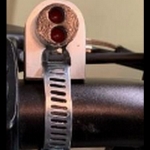Check out LM3914 bar graph LED drivers.
https://www.ti.com/lit/ds/symlink/lm3914.pdf
It's an absolutely amazing little chip. It needs almost no external components, and will give you a 10 LED bar graph of whatever voltage you're trying to measure. There's a sense pin that measures voltage, there's a low voltage pin where you apply the lowest voltage you want to display, and a high voltage pin where you want to apply your highest voltage. And it comes with an internal voltage reference so you can easily create these voltages. Then the chip will divide the highest and lowest voltages evenly and display them on the LEDs. Super amazing. I used to use them for makeshift speedometers, battery meters, and O2 sensor gauges.
Also it's totally analog so there's no programming, and the refresh speed is generally much faster than a uC.
And if you want to get really advanced you can daisy chain multiple LM3914s together to get bigger displays (the chip has provisions for this, because it's just built around a resistor divider network).


 LinkBack URL
LinkBack URL About LinkBacks
About LinkBacks


 Reply With Quote
Reply With Quote





Bookmarks